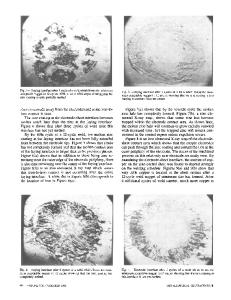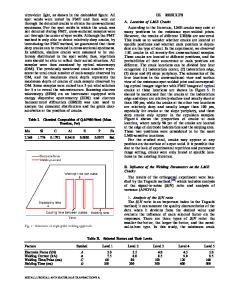The Mechanisms of Resistance Spot Welding of Magnesium to Steel
- PDF / 1,536,856 Bytes
- 11 Pages / 593.972 x 792 pts Page_size
- 26 Downloads / 343 Views
.
INTRODUCTION
THE continued efforts by automobile manufacturers to reduce vehicle weight have led to an increased use of high strength-to-weight-ratio magnesium alloys in the automobile architecture. Therefore, tasks of developing magnesium-to-magnesium similar joints and magnesium to others such as steel must be faced. The weldability of magnesium alloys by various methods, including laser,[1] friction stir,[2] laser-tungsten hybrid,[3] and resistance spot welding (RSW),[4] has been explored in detail. However, only a few studies have focused on the dissimilar joining of magnesium to steels. Butt joints[5] and overlap joints[6] of Mg to steel were performed by friction stir welding with a joint strength of around 70 pct of Mg base material and 3.7 kN (20 mm weld seam length), respectively. Laser-GTA (gas tungsten arc) hybrid welding was used to make overlap joints of Mg to steel.[7] However, it was hard to control these processes to avoid metallic oxides like MgO, ZnO, Fe2O3, or Al2O3,[5–7] which could reduce the strength of welds. The shear strength of dissimilar joints was improved from 56 pct to 100 pct of the base material by inserting a nickel interlayer.[8] RSW is a primary joining method in the auto industry. If dissimilar joints could be performed successfully by RSW, then the costs could be attractive as a result of the L. LIU, Ph.D. Candidate, is with the Department of Mechanical and Mechatronics Engineering, University of Waterloo, Waterloo N2L 3G1, Canada, and the State Key Laboratory of Advanced Welding Production Technology, Harbin Institute of Technology, Harbin 150001, P.R. China. L. XIAO, Ph.D. Candidate, and Y. ZHOU, Professor, are with the Department of Mechanical and Mechatronics Engineering, University of Waterloo. Contact e-mail: [email protected] J.C. FENG, Professor, and Y.H. TIAN, Assistant Professor, are with the State Key Laboratory of Advanced Welding Production Technology, Harbin Institute of Technology. S.Q. ZHOU, Professor, is with the School of Mechanical Science and Engineering, Huazhong University of Science and Technology, Wuhan 430074, P.R. China. Manuscript submitted December 5, 2009. Article published online June 22, 2010 METALLURGICAL AND MATERIALS TRANSACTIONS A
lack of need for new equipment and the inherent low-cost characteristics of RSW. Limited publications have focused on characteristics of Mg/Mg similar RSW joints, such as nugget growth characteristics,[9] effects of surface conditions and welding parameters,[4,10] and solidification morphologies.[11] However, virtually no literature has been published on the RSW of Mg to steel. Only a few studies on RSW of Al to steel have been published.[12–15] Mg-free Al foil was inserted between Al and steel to suppress the formation of an intermetallic layer.[12] An Al layer was cold rolled to steel as a transition to aid the resistance welding process.[14] A laminate of steel and Al was inserted between Al and steel so the same types of metals could face each other.[15] The main problems of welding Al to steel using RSW
Data Loading...











